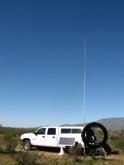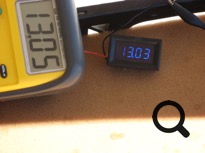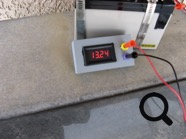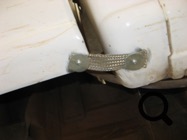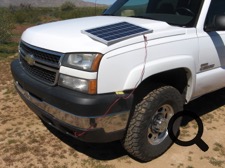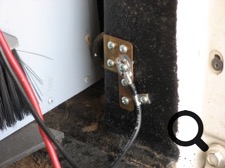DC Power
A 100w solar panel gives you plenty of juice for a 100w HF rig, and an amp or so even on full-overcast days. And it can also keep the rain and sun off of your "stuff"!! The 25w panels are nice when heavy current isn't needed.
Many PWM and MPPT solar charge-controllers generate RFI noise in radios, so try before you buy. The 7-amp Sunforce switching type from Amazon ($15) is completely quiet.
You can have a longer cable between the solar panel and the controller, but be sure to keep the length very short between the controller and the battery.
The little Smakn digital DC voltmeter (Amazon, $8) is awesome, and very accurate. Has two-digit accuracy, which I consider mandatory. Comes in blue or red digits. I made a little portable field-one out of a block of wood.
Big Battery Mistakes that everyone makes:
1) Picking the wrong battery is the biggest one. If you need a deep-cycle battery, don't buy a starting battery or a Marine/RV battery. A starting battery is the opposite of a deep-cycle, and a Marine/RV battery is a compromise between the two.
A true deep-cycle has heavy, thick plates that will provide many more charge/discharge cycles - and you can discharge them up to 50% (12.2v) without damage. Golf-cart and solar-system batteries are true deep-cycle.
As a general rule, if a battery has a CCA (Cold-Cranking Amps) spec (like CCA 650 or CCA 800), it is not a deep-cycle. Optima's are not deep-cycle !!
2) If you want long battery life, you must learn how to charge them properly. Never partially-charge a battery. And don't let a battery stay in a discharged or partially-discharged state for other than short periods.
3) Don't discharge a deep-cycle battery below 50% (12.2v). A starting battery should not be discharged below 90%.
If you want to use your vehicle battery to power a rig:
Even though my go-box has an internal 18ah battery for use with a solar-panel, I decided to rig up my truck so that I could use the two starting batteries (it's a diesel) in parallel for certain situations (like at night or with heavy cloud-cover). So here's how I did that:
I ran a really heavy positive cable (#6) from the battery up front to the rear "tailgate" operating position, with a short #10 pigtail on the end. You can get that heavy stuff at NAPA or Home Depot, by the foot. Make sure to put a heavy 30-amp automotive fuse right at the battery terminal, or you might have some "fireworks" at the business-end of that cable.
For the ground-side, I did not run a cable - I'm using the truck body as the return-side. I got a small piece of brass plate and screwed it to the truck sheet-metal near the tailgate with six self-tapping screws for lots of contact area. Then I soldered a short #10 wire pigtail to the plate. Make sure if you use this scheme that you install the heavy braid jumpers between the truck cab and the bed (see the Telescoping-Vertical antenna section). Those are also needed for a good RF ground-plane when using that vertical. I'm not positive that this works better than a heavy cable, but I think it does. And it's cheaper/easier !!
Don't be tempted to use the accessory 12v "hot" at the trailer-hitch connector. That run is usually #12 or #10 wire at best. Not nearly heavy enough !!
